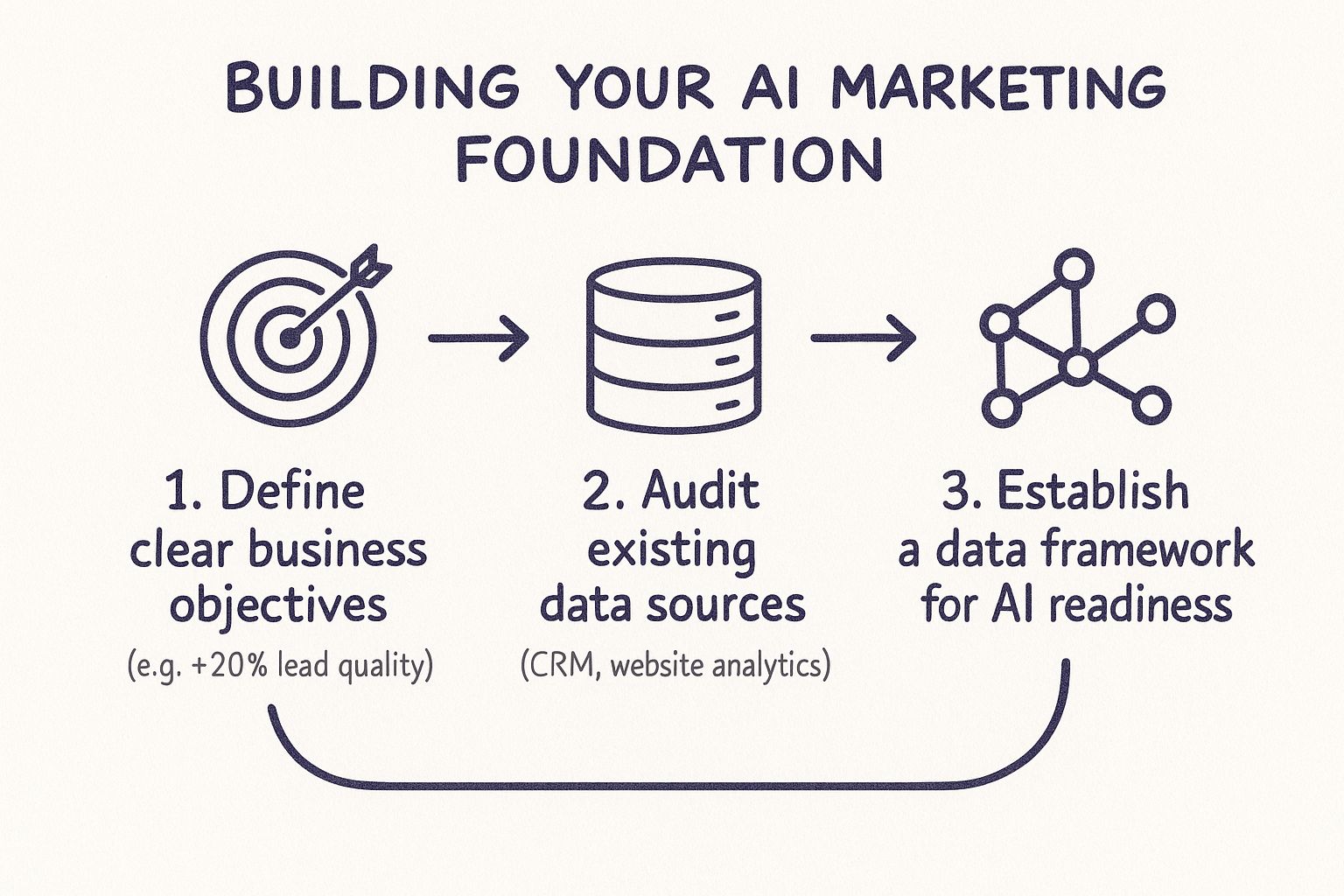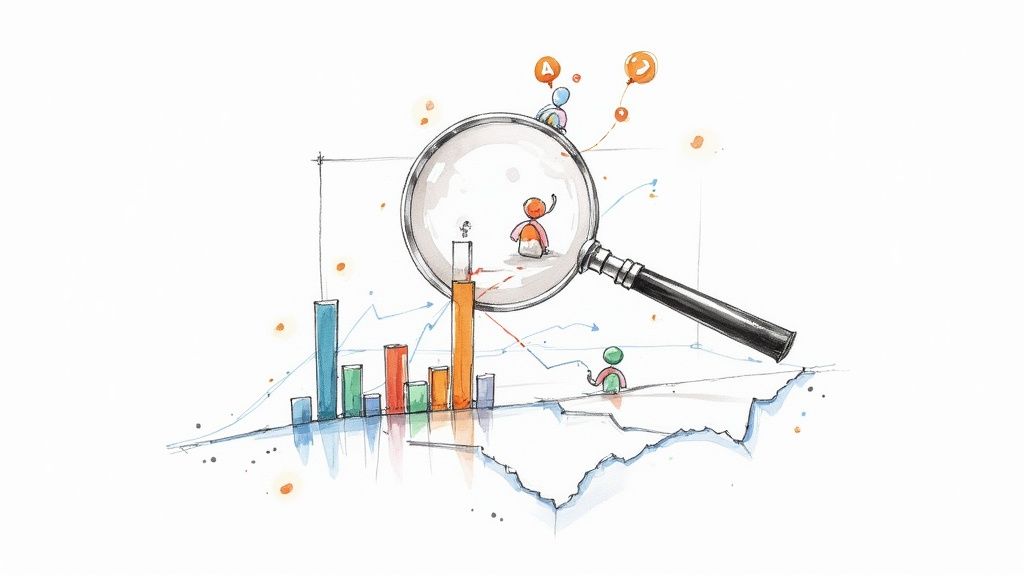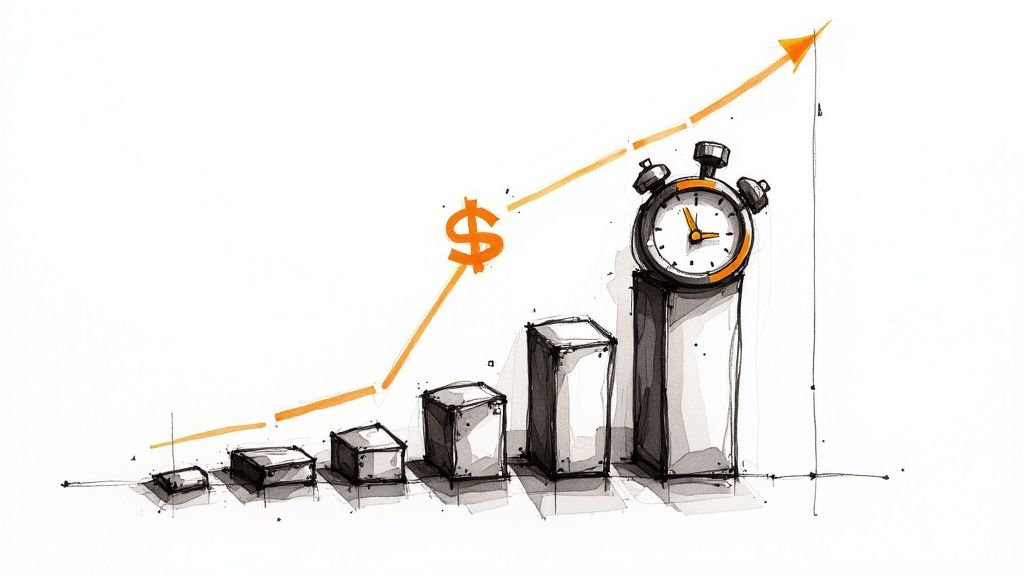
Mastering Lead Generation for Healthcare: Proven Strategies for 2025
Master lead generation for healthcare with proven strategies for 2025. Learn to attract, nurture, and convert quality leads in the complex healthcare market.

An AI-driven marketing strategy uses artificial intelligence to understand customer data, automate repetitive tasks, and predict trends. It's a significant evolution from traditional marketing, leveraging data to create highly personal and effective campaigns, which almost always translates to better results and a stronger return on investment.
Before diving into flashy AI tools, it’s essential to get the basics right. A successful AI-driven marketing strategy is less about the technology and more about clear objectives and clean, organized data.
Without this foundation, even the most advanced AI will be ineffective. The first step is to move beyond vague desires and define what success truly looks like for your business.
"More leads" is a wish, not a goal. A real goal is measurable. For instance, you could aim to improve the quality of marketing qualified leads (MQLs) by 20% this quarter or increase customer lifetime value by 15% in the next six months.
Providing your AI with a concrete target gives it a clear problem to solve.
Think of a well-defined objective as a compass for your AI. It ensures every automated decision and predictive insight pushes you toward a real business outcome, preventing wasted time and money on unfocused efforts.
Your AI is only as smart as the data you feed it. Garbage in, garbage out.
Begin with a simple audit of where your data currently resides. Examine your CRM, Google Analytics, social media reports, and email platform. Identify what information you have, where it is, and what's missing.
This process highlights the importance of a solid data framework. To learn more, check out our guide on the core principles of what data-driven marketing is. A quick audit is the first step toward building a reliable data ecosystem that allows your AI tools to perform at their best.
This infographic outlines the essential first steps for preparing your marketing for AI.

As shown, everything begins with clear goals. From there, a thorough data audit helps you establish a structured framework ready for AI integration.
The world of AI marketing tools is vast and can be overwhelming, with content generators like Jasper and analytics platforms like HubSpot emerging constantly.
The key is to focus on your specific business needs. The most advanced tool is useless if it doesn't solve a real problem for you. For instance, a local e-commerce store would benefit from an AI tool that creates dynamic, personalized social media ads. In contrast, a B2B SaaS company might gain more from a predictive lead-scoring tool integrated with their CRM.
Before investing, evaluate any potential tool against a few key criteria to ensure it's a strategic investment. I always consider these three factors:
AI in marketing is no longer a niche trend. By 2025, an estimated 80% of companies globally will use AI for marketing, with that figure rising to 85% in the Americas. You can get more details about AI marketing adoption rates to understand its prevalence. Choosing tools wisely is now essential.
This table compares popular AI marketing tools by function to help you find the right fit.
Selecting the right combination creates a powerful AI marketing stack. Start with your biggest challenge and find a tool that solves it, then build from there.
Exploring top options can guide your decision-making. Consider resources on the 12 Best AI Powered Marketing Tools for 2025 to see what leading solutions offer.

With your foundation and tools in place, it’s time to launch your AI-driven marketing campaigns. This is where planning becomes execution, and you start creating campaigns that connect with people on a deeper level.
AI enables hyper-personalization at a scale previously unimaginable. It can analyze browsing history, purchase behavior, and site interactions to create unique email copy for different customer segments automatically.
This is a complete shift from the "one-size-fits-all" approach. With a global AI user base of 378 million people, your audience now expects smarter, more relevant brand interactions. If you want to discover more insights about AI adoption statistics, you'll see how widespread it has become.
Your content strategy gets a major upgrade with AI. Instead of guessing topics, AI tools can analyze search trends, competitor activity, and social media conversations to identify what your audience is looking for. This allows you to generate detailed, SEO-ready outlines to guide your content creation.
The impact on paid advertising is equally significant. An AI marketing strategy automates the heavy lifting:
By letting machines handle these data-heavy tasks, your team is freed up for strategic and creative thinking. The goal is a self-improving engine that gets smarter over time.
This level of optimization directly impacts revenue. For a deeper look, see our guide on how to increase website conversions and learn how these refinements pay off.

An AI-driven marketing strategy isn't a "set it and forget it" project. It's a living system that requires constant attention to learn and improve. The magic happens when you use AI not just for execution but also for analysis, spotting patterns and enabling smarter, faster decisions.
This feedback loop is crucial. AI analytics can process vast amounts of data to reveal insights a human analyst might miss, such as identifying the most profitable customer personas or pinpointing leads ready to convert.
Your job won't be taken by AI, but by someone who knows how to use it. The true value lies in directing these tools to find insights and acting on them strategically.
While A/B testing is common, AI elevates it by testing thousands of ad variations simultaneously—different headlines, images, and CTAs. It can manage this massive testing environment and automatically allocate more budget to the winning combinations in real time.
This approach requires a shift in how we measure success. Instead of vanity metrics like likes or impressions, an AI-powered strategy demands a focus on KPIs that drive business growth.
Tracking these metrics provides a clear view of your campaign's financial health. To learn more, explore how to calculate marketing ROI and connect your AI efforts directly to business growth.

Ultimately, the excitement around an AI-driven marketing strategy is about tangible results that fuel business growth.
AI automates the manual, repetitive tasks that consume your team's time. Instead of pulling reports or sifting through data, they can focus on high-level strategy and creative thinking. This makes their work more valuable and impactful.
AI accelerates revenue-generating processes. It can produce first drafts for blog posts, social media schedules, or ad copy variations in minutes, not hours. This allows your team to experiment more and launch campaigns faster.
In sales, AI can score leads and identify prospects ready to buy, allowing your team to focus on high-potential opportunities. This leads to better close rates and shorter sales cycles.
The real magic of AI is how it shifts your team from reactive task-doers to proactive strategists, equipping them with the data and automation needed for measurable growth.
The numbers speak for themselves. The global AI marketing industry is projected to grow from $47.32 billion in 2025 to over $107 billion by 2028.
This is happening now. 88% of marketers already use AI in their daily work, and 92% of businesses plan to increase their AI spending. You can discover more about these AI statistics to see the scale of this shift.
Investing in an AI-driven marketing strategy is no longer optional; it's essential for staying competitive and achieving sustainable growth.
Adopting a new strategy raises questions. Let's address some common concerns about AI marketing to help you move forward with confidence.
Start small. Focus on a single, high-impact area that is currently a major pain point.
Don't try to overhaul everything at once. Choose one tool that solves a specific problem, such as an AI-powered email platform for A/B testing subject lines or better audience segmentation. Content ideation and SEO research are also great starting points. The goal is to prove the concept, measure results, and then expand.
Budgets vary widely, from free trials to enterprise solutions. For a small or mid-sized business, a budget of $100 to $500 per month is often sufficient to access a few specialized, high-impact tools.
The crucial element is not the dollar amount but connecting spending to an expected outcome. Before purchasing, ask, "How will this tool save my team time or generate more revenue?" This ensures you're investing in solutions, not just software.
The short answer is no. AI is more likely to transform marketing jobs than eliminate them.
AI excels at automating tedious, repetitive tasks, freeing up marketers to focus on high-level strategy, creative thinking, and building customer relationships. The marketer's role is evolving into that of an "AI orchestrator"—someone who guides these powerful tools to achieve business goals. Teams that embrace AI and learn these new skills will become more valuable than ever.
Ready to see what a true outcome-driven marketing strategy can do for your business? At BrandBooster.ai, we combine expert strategy with advanced AI to deliver real returns on your advertising spend in 60 days, guaranteed. Learn more about how we can help you grow.